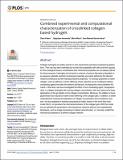Por favor, use este identificador para citar o enlazar a este item:
http://hdl.handle.net/10261/180538COMPARTIR / EXPORTAR:
 SHARE SHARE
 CORE
BASE CORE
BASE
|
|
| Visualizar otros formatos: MARC | Dublin Core | RDF | ORE | MODS | METS | DIDL | DATACITE | |

| Título: | Combined experimental and computational characterization of crosslinked collagenbased hydrogels |
Autor: | Valero, Clara; Amaveda, H. CSIC ORCID; Mora Alfonso, Mario CSIC ORCID; García-Aznar, Jose Manuel | Fecha de publicación: | 2018 | Editor: | Public Library of Science | Citación: | PLoS ONE 13(4): e0195820 (2018) | Resumen: | Collagen hydrogels are widely used for in-vitro experiments and tissue engineering applications. Their use has been extended due to their biocompatibility with cells and their capacity to mimic biological tissues; nevertheless their mechanical properties are not always optimal for these purposes. Hydrogels are formed by a network of polymer filaments embedded on an aqueous substrate and their mechanical properties are mainly defined by the filament network architecture and the individual filament properties. To increase properties of native collagen, such as stiffness or strain-stiffening, these networks can be modified by adding crosslinking agents that alter the network architecture, increasing the unions between filaments. In this work, we have investigated the effect of one crosslinking agent, transglutaminase, in collagen hydrogels with varying collagen concentration. We have observed a linear dependency of the gel rigidity on the collagen concentration. Moreover, the addition of transglutaminase has induced an earlier strain-stiffening of the collagen gels. In addition, to better understand the mechanical implications of collagen concentration and crosslinkers inclusion, we have adapted an existing computational model, based on the worm-like chain model (WLC), to reproduce the mechanical behavior of the collagen gels. With this model we can estimate the parameters of the biopolymer networks without more sophisticated techniques, such as image processing or network reconstruction, or, inversely, predict the mechanical properties of a defined collagen network. | Versión del editor: | https://doi.org/10.1371/journal.pone.0195820 | URI: | http://hdl.handle.net/10261/180538 | DOI: | 10.1371/journal.pone.0195820 | ISSN: | 1932-6203 |
| Aparece en las colecciones: | (ICMA) Artículos |
Ficheros en este ítem:
| Fichero | Descripción | Tamaño | Formato | |
|---|---|---|---|---|
| combihydrogel.pdf | 4,85 MB | Adobe PDF |  Visualizar/Abrir |
CORE Recommender
PubMed Central
Citations
27
checked on 24-mar-2024
SCOPUSTM
Citations
64
checked on 15-abr-2024
WEB OF SCIENCETM
Citations
56
checked on 26-feb-2024
Page view(s)
163
checked on 19-abr-2024
Download(s)
130
checked on 19-abr-2024

